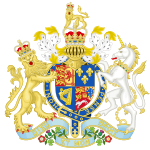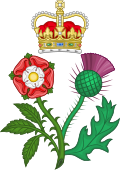Summary of the members of Parliament
Key to categories in the following tables: BC - Borough/Burgh constituencies, CC - County constituencies, UC - University constituencies, Total C - Total constituencies, BMP - Borough/Burgh Members of Parliament, CMP - County Members of Parliament, UMP - University Members of Parliament.
Table 1: Constituencies and MPs, by type and country
| Country | BC | CC | UC | Total C | BMP | CMP | UMP | Total MPs |
|---|
| England | 202 | 39 | 2 | 243 | 404 | 78 | 4 | 486 |
| Wales | 13 | 13 | 0 | 26 | 13 | 14 | 0 | 27 |
| Scotland | 15 | 30 | 0 | 45 | 15 | 30 | 0 | 45 |
| Total | 230 | 82 | 2 | 314 | 432 | 122 | 4 | 558 |
Table 2: Number of seats per constituency, by type and country
| Country | BCx1 | BCx2 | BCx4 | CCx1 | CCx2 | UCx2 | Total C |
|---|
| England | 4 | 196 | 2 | 0 | 39 | 2 | 243 |
| Wales | 13 | 0 | 0 | 12 | 1 | 0 | 26 |
| Scotland | 15 | 0 | 0 | 30 | 0 | 0 | 45 |
| Total | 32 | 196 | 2 | 42 | 40 | 2 | 314 |
Party Composition: An estimate of the approximate Party composition was Whig 291 and Tory 222.
Speaker and ministries
On 16 November 1708, Sir Richard Onslow, Bt (1654-1717), MP (Whig) for Surrey since 1689, was elected the second Speaker of the House of Commons of Great Britain.
This Parliament was held before the office of Prime Minister had formally come into existence. However the Lord High Treasurer (or when that office was in commission the First Lord of the Treasury) was the most powerful and important minister of the Crown. The Lord High Treasurer at that time (in office in England and then Great Britain since 8 May 1702) was Sidney Godolphin, 1st Earl of Godolphin. Godolphin was a Tory, but the Ministry, as last reconstructed in February 1708, included both Tory and Whig members. The factions supporting the Ministry (the 'Court Party') were the Churchill Tories (followers of John Churchill, 1st Duke of Marlborough), Court Tory and Whig supporters of any Ministers the Queen cared to appoint, the Walpole-Townshend Whigs and Junto Whigs. They were opposed by the 'Country Party'. The main task of the Ministry was to support Marlborough's armies in continental Europe during the War of the Spanish Succession and Godolphin's financial expertise was essential to that task.
Queen Anne initiated a complete change of Ministry in August 1710. To an extent unusual in the period Godolphin and his friends were all removed from office. A new Ministry was constructed composed of Court Party supporters and Tory groups led by Robert Harley, Laurence Hyde, 1st Earl of Rochester and Henry St John. Harley, the ambitious member for Radnor Boroughs, had become associated with the Tories since Godolphin and Marlborough had forced his resignation from the government in 1708.
On 10 August 1710, the office of Lord High Treasurer was put in commission. John Poulett, 1st Earl Poulett became First Lord of the Treasury and Robert Harley the Chancellor of the Exchequer (and Second Lord of the Treasury).
Soon after taking office the new Ministers arranged for Parliament to be dissolved.
The Whigs were a political party in the Parliaments of England, Scotland, Ireland, Great Britain and the United Kingdom. Between the 1680s and the 1850s, the Whigs contested power with their rivals, the Tories. The Whigs became the Liberal Party when it merged with the Peelites and Radicals in the 1850s. Many Whigs left the Liberal Party in 1886 over the issue of Irish Home Rule to form the Liberal Unionist Party, which merged into the Conservative Party in 1912.

Anne was Queen of England, Scotland, and Ireland from 8 March 1702, and Queen of Great Britain and Ireland following the ratification of the Acts of Union 1707 merging the kingdoms of Scotland and England, until her death in 1714.
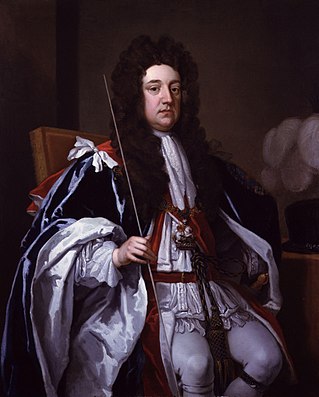
Sidney Godolphin, 1st Earl of Godolphin, was an English Tory politician and peer. He was a Privy Councillor and Secretary of State for the Northern Department before he attained real power as First Lord of the Treasury. He was instrumental in negotiating and passing the Acts of Union 1707 with Scotland, which created the Kingdom of Great Britain. He had many other roles, including that of Governor of Scilly.

Robert Harley, 1st Earl of Oxford and Earl Mortimer, KG PC FRS was an English statesman and peer of the late Stuart and early Georgian periods. He began his career as a Whig, before defecting to a new Tory ministry. He was raised to the peerage of Great Britain as an earl in 1711. Between 1711 and 1714 he served as Lord High Treasurer, effectively Queen Anne's chief minister. He has been called a prime minister, although it is generally accepted that the de facto first minister to be a prime minister was Robert Walpole in 1721.

This is a list of the principal Ministers of the Crown of the Kingdom of England, and then of the Kingdom of Great Britain, from May 1702, at the beginning of the reign of Queen Anne. During this period, the leaders of the ministry were Lord Godolphin and the Duke of Marlborough.
The First Whig Junto controlled the government of England from 1694 to 1699 and was the first part of the Whig Junto, a cabal of people who controlled the most important political decisions. The Junto was reappointed twice following the elections of 1695 and 1698.

Henry Boyle, 1st Baron Carleton, was an Anglo-Irish Whig politician who sat in the Irish House of Commons from 1692 to 1695 and in the English and British House of Commons between 1689 and 1710. He served as Chancellor of the Exchequer and Secretary of State, and after he was raised to the peerage as Baron Carleton, served as Lord President of the council.

Abigail Masham, Baroness Masham, was an English courtier. She was a favourite of Queen Anne, and a cousin of Sarah, Duchess of Marlborough.
Dysart Burghs was a district of burghs constituency of the House of Commons of Great Britain from 1708 to 1801 and of the House of Commons of the United Kingdom from 1801 to 1832. It elected one Member of Parliament (MP).

The first Parliament of the Kingdom of Great Britain was established in 1707 after the merger of the Kingdom of England and the Kingdom of Scotland. It was in fact the 4th and last session of the 2nd Parliament of Queen Anne suitably renamed: no fresh elections were held in England or in Wales, and the existing members of the House of Commons of England sat as members of the new House of Commons of Great Britain. In Scotland, prior to the union coming into effect, the Scottish Parliament appointed sixteen peers and 45 Members of Parliaments to join their English counterparts at Westminster.
The Whig Junto is the name given to a group of leading Whigs who were seen to direct the management of the Whig Party and often the government, during the reigns of William III and Anne. The Whig Junto proper consisted of John Somers, later Baron Somers; Charles Montagu, later Earl of Halifax; Thomas Wharton, later Marquess of Wharton, and Edward Russell, later Earl of Orford. They came to prominence due to the favour of Robert Spencer, 2nd Earl of Sunderland and during the reign of Queen Anne, Sunderland's son, the 3rd Earl succeeded his father. Opponents gave them the nickname "the five tyrannising lords". Other figures prominent around the edges of the Junto include Sir John Trenchard and Thomas Tollemache.
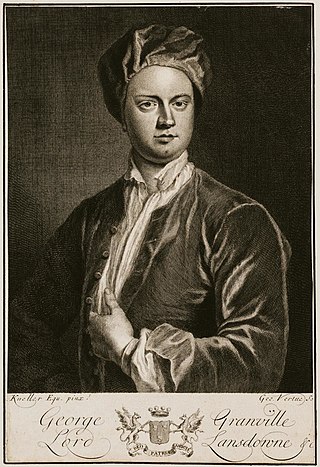
George Granville, 1st Baron Lansdowne PC, of Stowe, Cornwall, was an English Tory politician who sat in the English and British House of Commons from 1702 until 1712, when he was raised to the peerage as Baron Lansdown and sat in the House of Lords. He was Secretary at War during the Harley administration from 1710 to 1712. He was also a noted poet and made a name for himself with verses composed on the visit of Mary of Modena, then Duchess of York, while he was at Cambridge in 1677. He was also a playwright, following in the style of John Dryden.

Francis Godolphin, 2nd Earl of Godolphin,, styled Viscount Rialton from 1706 to 1712, was an English courtier and politician who sat in the English and British House of Commons between 1695 and 1712, when he succeeded to the peerage as Earl of Godolphin. Initially a Tory, he modified his views when his father headed the Administration in 1702 and was eventually a Whig. He was a philanthropist and one of the founding governors of the Foundling Hospital in 1739.

The 1710 British general election produced a landslide victory for the Tories. The election came in the wake of the prosecution of Henry Sacheverell, which had led to the collapse of the previous government led by Godolphin and the Whig Junto.

John Fane, 7th Earl of Westmorland, styled The Honourable John Fane from 1691 to 1733 and Lord Catherlough from 1733 to 1736, of Mereworth Castle in Kent, was a British Army officer and politician who sat in the House of Commons in three separate stretches between 1708 and 1734.

James Johnston was a Scottish diplomat and Tory politician who served as envoy extraordinary to Prussia from 1690 to 1692. He also served Secretary of State, Scotland from 1692 to 1696 and Lord Clerk Register from 1704 to 1705. Johnston sat in the House of Commons of Great Britain from 1708 to 1713.

Sir John Evelyn, 1st Baronet of Wotton, Surrey, was a British official and politician who sat in the House of Commons from 1708 to 1710. His grandfather, the diarist John Evelyn, influenced his independent attitude in politics and stimulated his dedication to literature. His public offices included Postmaster-general from 1708 to 1715.
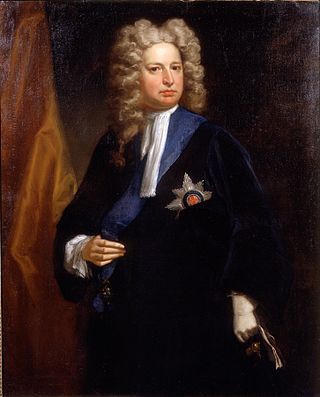
The Harleyministry was the British government that existed between 1710 and 1714 in the reign of Queen Anne. It was headed by Robert Harley and composed largely of Tories. Harley was a former Whig who had changed sides, bringing down the seemingly powerful Whig Junto and their moderate Tory ally Lord Godolphin. It came during the Rage of Party when divisions between the two factions were at their height, and a "paper war" broke out between their supporters. Amongst those writers supportive of Harley's government were Jonathan Swift, Daniel Defoe, Delarivier Manley, John Arbuthnot and Alexander Pope who clashed with members of the rival Kit-Kat Club.
Robert Monckton was an English landowner and Whig politician who sat in the English and British House of Commons between 1695 and 1713. He took an active part supporting William of Orange in the Glorious Revolution, and was notable for his involvement in a number of exceptionally bitter and prolonged electoral disputes.

The 1st Parliament of Queen Anne was summoned by Queen Anne of England on 2 July 1702 and assembled on 20 August 1702. Its composition was 298 Tories, 184 Whigs and 31 others, representing a large swing to the Tories since the previous election. Robert Harley, the member for Radnor, was re-elected Speaker of the House of Commons.

